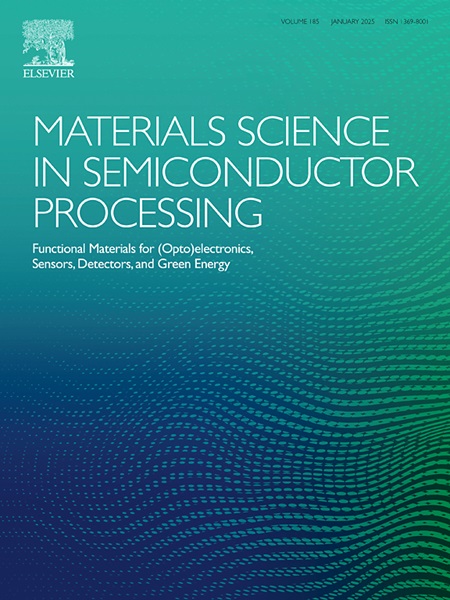Sensitive rutin detection at nanomolar levels utilizing CeO2/BaO@Ti3C2Tx nanocomposite-based photoelectrochemical sensor
IF 4.2
3区 工程技术
Q2 ENGINEERING, ELECTRICAL & ELECTRONIC
引用次数: 0
Abstract
Natural compounds like Rutin (RT) are widely utilized in medical settings, making it crucial to evaluate the efficacy and scientific basis of drugs derived from such sources. This study focuses on the synthesis of oxides of cerium and barium (CeO2/BaO) doped with MXene (Ti3C2Tx) compounds through a straightforward wet chemical etching process and sonochemical technique to facilitate the rapid detection of RT using a photoelectrochemical (PEC) sensor. Electrocatalytic reactions rely on electrical energy, while photocatalytic reactions use light energy to generate oxidizing agents. The integration of light and electrical energy in photoelectrocatalytic oxidation, utilizing semiconducting nanostructures, has proven effective for oxidizing RT. Using cyclic voltammetry (CV) and linear sweep voltammetry (LSV), we investigated the PEC properties of RT on a CeO2/BaO@Ti3C2Tx modified electrode, assessing its stability and sensitivity to change in pH, loading, sweep rate, and potential interferences. The CeO2/BaO@Ti3C2Tx modified electrode exhibits rapid RT detection under optimal conditions, with a linear detection range of 0.1–1.4 μM, and a low detection limit of 1.16 nM. PEC analysis also revealed that the CeO2/BaO@Ti3C2Tx electrode maintains cyclic stability and robust anti-interference performance. This nanocomposite showed satisfactory recovery rates when detecting RT in lemon, orange, and grape samples. Compared to other potential interfering substances, the sensor demonstrated high selectivity and resistance to interference. Consequently, this research advances the development of PEC sensors for biomedical and therapeutic applications.
利用 CeO2/BaO@Ti3C2Tx 纳米复合材料光电化学传感器灵敏检测纳摩尔级芦丁
芦丁(RT)等天然化合物被广泛应用于医疗领域,因此评估从此类来源提取的药物的疗效和科学依据至关重要。本研究的重点是通过直接的湿化学蚀刻工艺和声化学技术合成掺杂有 MXene(Ti3C2Tx)化合物的铈和钡氧化物(CeO2/BaO),以便利用光电化学(PEC)传感器快速检测 RT。电催化反应依赖于电能,而光催化反应则利用光能产生氧化剂。利用半导体纳米结构将光能和电能整合到光电催化氧化反应中,已被证明可有效氧化 RT。我们使用循环伏安法(CV)和线性扫描伏安法(LSV)研究了经修饰的 CeO2/BaO@Ti3C2Tx 电极上 RT 的光电催化特性,评估了其稳定性以及对 pH 值变化、负载、扫描速率和电位干扰的敏感性。在最佳条件下,CeO2/BaO@Ti3C2Tx修饰电极能快速检测RT,线性检测范围为0.1-1.4 μM,检测限低至1.16 nM。PEC 分析还显示,CeO2/BaO@Ti3C2Tx 电极保持了循环稳定性和强大的抗干扰性能。在检测柠檬、橙子和葡萄样品中的 RT 时,这种纳米复合材料显示出令人满意的回收率。与其他潜在干扰物质相比,该传感器具有高选择性和抗干扰性。因此,这项研究推动了用于生物医学和治疗应用的 PEC 传感器的发展。
本文章由计算机程序翻译,如有差异,请以英文原文为准。
求助全文
约1分钟内获得全文
求助全文
来源期刊

Materials Science in Semiconductor Processing
工程技术-材料科学:综合
CiteScore
8.00
自引率
4.90%
发文量
780
审稿时长
42 days
期刊介绍:
Materials Science in Semiconductor Processing provides a unique forum for the discussion of novel processing, applications and theoretical studies of functional materials and devices for (opto)electronics, sensors, detectors, biotechnology and green energy.
Each issue will aim to provide a snapshot of current insights, new achievements, breakthroughs and future trends in such diverse fields as microelectronics, energy conversion and storage, communications, biotechnology, (photo)catalysis, nano- and thin-film technology, hybrid and composite materials, chemical processing, vapor-phase deposition, device fabrication, and modelling, which are the backbone of advanced semiconductor processing and applications.
Coverage will include: advanced lithography for submicron devices; etching and related topics; ion implantation; damage evolution and related issues; plasma and thermal CVD; rapid thermal processing; advanced metallization and interconnect schemes; thin dielectric layers, oxidation; sol-gel processing; chemical bath and (electro)chemical deposition; compound semiconductor processing; new non-oxide materials and their applications; (macro)molecular and hybrid materials; molecular dynamics, ab-initio methods, Monte Carlo, etc.; new materials and processes for discrete and integrated circuits; magnetic materials and spintronics; heterostructures and quantum devices; engineering of the electrical and optical properties of semiconductors; crystal growth mechanisms; reliability, defect density, intrinsic impurities and defects.
 求助内容:
求助内容: 应助结果提醒方式:
应助结果提醒方式:


